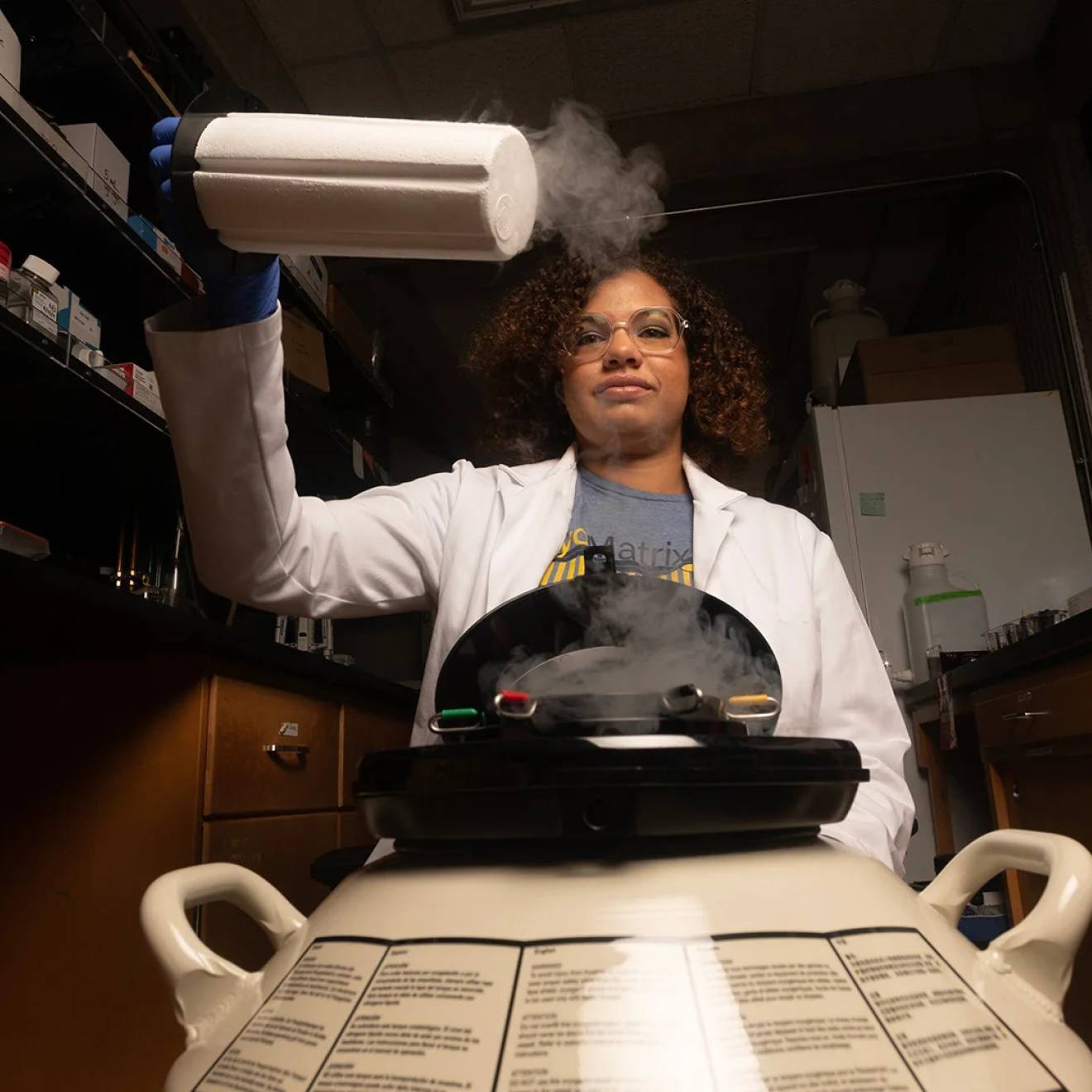Kim McDonald, UC San Diego

When students ask Stephen Mayfield what to do when they graduate — what sort of career would provide them with a decent income, expanding professional opportunities and a chance to give back to society — the UC San Diego biology professor is quick to respond.
“Work on the next Green Revolution,” he says.
“Working on the Green Revolution 2.0 is the most important thing that students can do,” Mayfield told a gathering of researchers from around the world who traveled to campus last week for a two-day symposium on developing ways to dramatically improve the world’s production of food and renewable fuels. “That’s far more important in my opinion than designing new apps.”
What’s the Green Revolution 2.0?
From the 1940s and continuing throughout the 1960s, agricultural scientists saved more than a billion people worldwide from starvation by developing high yielding varieties of crops, synthetic fertilizers and pesticides, improved irrigation practices and better land management. This was called the “Green Revolution.”
Now scientists are confronted with a more difficult problem: How to feed and provide fuel for countries such as India, Brazil, Mexico and China, which are not only projected to dramatically expand their populations in the decades ahead, but have rapidly developing economies that will require an exponential increase in fuel and food. What the world needs to satisfy those demands, say many scientists, is a second Green Revolution.
Last week’s symposium on the scientific challenges ahead, appropriately called “Green Revolution 2.0,” was hosted by the campus’ Center for Food and Fuel for the 21st Century, of which Mayfield is a co-director, and the California Center for Algae Biotechnology, which Mayfield also directs. It also involved as speakers researchers from other UC campuses who are participating in the new University of California Global Food Initiative — an effort that has brought together researchers on the University of California’s 10 campuses, affiliated national laboratories and the Division of Agriculture and Natural Resources — “to develop and export solutions for food security, health and sustainability throughout California, the United States and the world.”
“The goal is to help the world meet its increasing demand for food and fuel as the world’s population grows from seven billion people to an estimated nine billion by 2050,” said Julian Schroeder, a biology professor and the other co-director of UC San Diego’s Center for Food and Fuel for the 21st Century. “How can we do this in a sustainable manner in a rapidly changing environment, with rising carbon-dioxide levels, limited water resources and pathogens and pests? These are some of the questions scientists within the UC system and our collaborators around the world are attempting to address in their research.”
Although the UC San Diego center has held similar symposia on food and fuel in each of the past four years, Mayfield told the gathering that “this meeting is more essential now than ever before. There are more people on the planet, food is more expensive and every year the crisis gets a little worse.”
“Either we become more efficient at producing food and fuel or we reduce the demand on these resources,” he added.
As the director of Cal-CAB, the California Center for Algae Biotechnology, Mayfield is bringing together academic plant biologists in California with local companies trying to develop biofuels from algae as fuel for automobiles and jets, with the hope that these fuels eventually would be economically competitive to gasoline and diesel produced from the world’s dwindling supplies of petroleum.
In just the past four years, he said, oil companies spent $2.4 trillion looking for new sources of oil because those sources are harder to locate and extract than ever before. “It’s outrageously expensive to find new sources of oil and we’re not replacing it at the rate we’re burning it,” he added.
Dan Fishman, a technology manager in the Bioenergy Technologies Office of the U.S. Department of Energy, said that 67 percent of U.S. gasoline consumption is transportation related and that new biofuel developments are being supported by his agency as a way to not only reduce oil imports, but meet the nation’s goals of reducing greenhouse emissions.
In addition to biofuel production from ethanol and algae, researchers at the meeting discussed the latest advances in fuel production from the seeds of a drought-resistant shrub called Jatropha that can be easily grown on marginal land not suited for farming.
Robert Schmidt, a former UC San Diego biology professor who had been studying the genetics of maize and Jatropha, left the campus in 2012 to become the chief scientific officer for SG Biofuels, a San Diego company developing Jatropha — long cultivated for its seed oil to make soaps and candles — to help farmers around the world make gasoline and jet fuel for the military and commercial airlines.
Schmidt said that in the past three years his company had developed 15 hybrids of Jatropha that can produce far more oil than the original shrub. He said the introduction of hybrid corn during the Green Revolution of the 1940s increased by 400 percent the yield in corn crops and that his company has been able to achieve similar gains in the dry seed weight of Jatropha shrubs, which produced 0.4 metric tons per hectare in the first hybrids in 2010 to 7 metric tons in 2014.
Although Jatropha was regarded as a biofuel crop with limited commercial potential only six years ago, Schmidt said the new hybrids have renewed interest in the shrub. “We’ve accelerated the time to maturity in Jatropha,” he added. “This changes things now and will help drive the economics of this oil seed crop.”
Producing biofuels from Jatropha and algae would limit the amount of corn and other food crops from being diverted to biofuel production. Eric Schmelz, a biology professor at UC San Diego who is studying the genetics of insect and fungal pests in maize, said that 35 percent of the corn crop in the U.S. over the past 10 years has been devoted to producing ethanol. As a result, the value of this crop, which reached $1.7 trillion in 2013, has encouraged farmers to plant more corn on their land through every growing season and not rotate their farmland with crops, resulting in more exposure of the corn to pests and disease.
Scientists have discovered that some plants have the ability to produce small molecules with anti-microbial or anti-fungal activity to ward off common plant diseases. Although researchers have long thought this ability was not present in maize, Schmelz has discovered that such compounds are produced by corn plants in response to stress, such as drought. These compounds, which he is studying, appear to be toxic to fungi and the European corn borer, which causes more than $1 billion in crop losses annually.
A surprisingly small percentage of the corn crop — only 10 percent — is eaten by humans for food. But because much of the rest is used for ethanol production or to feed animals eaten by humans, increases in the price of corn can lead to sharp increases in the price of beef, poultry and other basic food commodities. That’s one of the reasons the next Green Revolution will need to find new ways of producing renewable fuels inexpensively — from Jatropha, algae or farm waste — as the world’s oil supplies dwindle.
James Hamilton, a professor of economics at UC San Diego, develops statistical models to predict the rise and fall of gas prices from a number of social and economic trends. He said the price per barrel of the U.S. benchmark West Texas intermediate oil has dropped to $43 today from a high of nearly $140 in 2008 because of declines in economic activity worldwide, particularly in China, excess oil production, improvements in the fuel economy of U.S. cars and the aging of the world’s population. Older people basically drive less, he pointed out.
But that downward trend in energy prices, Hamilton added, is likely to spike sharply upward again when the excess oil capacity is curtailed and global economic activity resumes.
“It will be difficult to increase demand worldwide to match the economic activity from developing countries,” he warned. “It’s hard to look at the data and not see this as the elephant in the room.”

